According to Wikipedia, “a programming language is a formal language comprising a set of strings that produce various kinds of machine code output.” In other words, computers only understand 0s and 1s, so programming languages allow humans to deliver instructions to the computer in a way the computer can understand.
Programming languages are the interface through which developers make computers perform different tasks, such as notifying an application's user about an update. There are numerous programming languages available to developers, with each programming language having its own set of rules and syntax. Some programming languages are built for specific purposes, while others are designed for more general purposes.
General purpose programming languages are used by a large number of developers. More developers using a language means more applications are built with it, which attracts more developers who learn and use the language. This flywheel effect causes changes in the popularity of programming languages, while changes in technological paradigms can also affect how programming languages are used.
In this guide, we’ll discuss:
- Programming Language Popularity
- How We Selected the Most Popular Programming Languages
- MagicBell’s Top 10 Programming Languages
Programming Language Popularity
What constitutes the popularity of a programming language? The short answer is that there are numerous factors to take into consideration.
For example, is the most popular programming language the one with:
- the most number of developers?
- the most number of applications developed?
- the most lines of code written?
- the most searches?
- the most job openings?
- the highest number of end users?
There can be an endless number of parameters that can go into the popularity of a programming language, and each of the different parameters has its own set of advantages and disadvantages. This makes it difficult to determine the most popular languages. So, which parameters should we consider?
How We Selected the Most Popular Programming Languages
Due to the multi-faceted nature of programming languages and what constitutes their popularity, compiling and organizing a list of the most popular can be problematic at best. Many organizations have conducted research in effort to achieve this goal, with each organization taking a different approach to solving the problem.
In order to determine the most popular languages, we tracked the number of mentions each language received in the different primary research findings. This methodology provides a more accurate, combined summary of the various findings than simply taking the results of one finding alone.
GitHub
GitHub, the prominent code repository, determines the most popular programming languages every year. GitHub relies on the millions of repositories hosted on the platform to arrive at the results. The top 10 programming languages according to GitHub’s 2021 State of the Octoverse Report are listed below.
- JavaScript
- Python
- Java
- TypeScript
- C#
- PHP
- C++
- Shell
- C
- Ruby
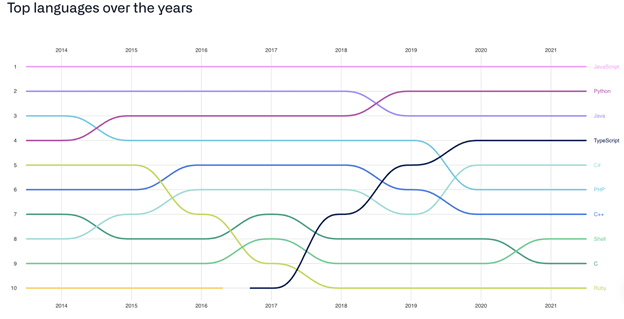
Screenshot from Octoverse
Statista
Statista specializes in marketing and consumer data, and its list of the most popular programming languages is based on the results of stakeholder surveys.
According to Statista, the top 10 programming languages of 2021 are as follows:
- JavaScript
- HTML/CSS
- Python
- SQL
- Java
- Node.js
- Typescript
- C#
- Bash/Shell/Powershell
- C++
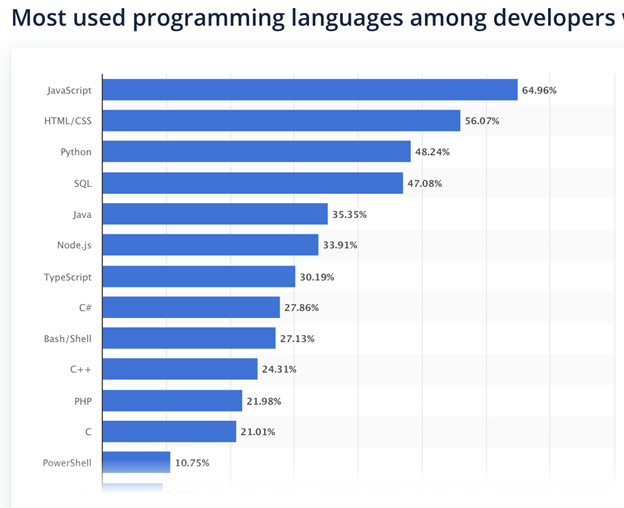
Screenshot from Statista
TIOBE
TIOBE is a software code quality company. Their programming language rankings are determined by several factors, such as the number of skilled engineers worldwide, the number of available courses, and the number of third-party vendors.
The rankings are updated every month, and their top 10 programming languages for November 2021 are listed below.
- Python
- C
- Java
- C++
- C#
- Visual Basic
- JavaScript
- Assembly Language
- SQL
- PHP
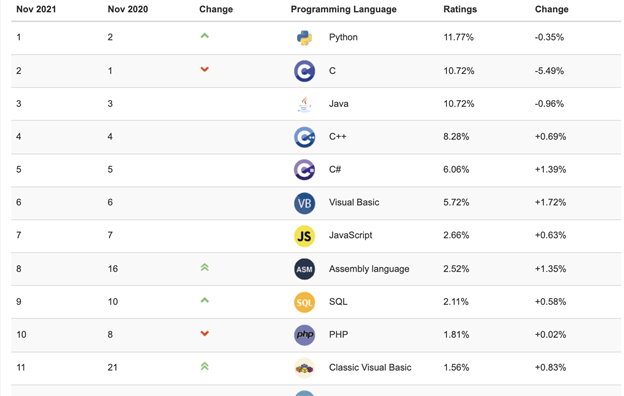
Screenshot from TIOBE.com
RedMonk
RedMonk is a developer-focused industry analysis firm that publishes a list of the top programming languages every quarter. They use publicly available GitHub information to determine the popular programming languages and rank the languages according to the number of projects on GitHub.
The top 10 programming languages as of June 2021 according to RedMonk are:
- JavaScript
- Python
- Java
- PHP
- CSS
- C++
- C#
- TypeScript
- Ruby
- C
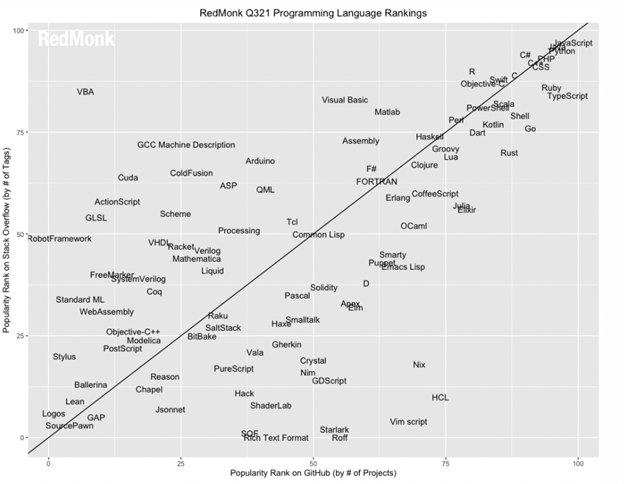
Screenshot from Redmonk
PYPL Index
The PYPL (PopularitY of Programming Language) Index is another publicly available ranking that’s determined by analyzing how often language tutorials are searched for on Google. According to the PYPL Index, the top 10 programming languages for November 2021 are:
- Python
- Java
- JavaScript
- C#
- C/C++
- PHP
- R
- Objective-C
- Swift
- TypeScript
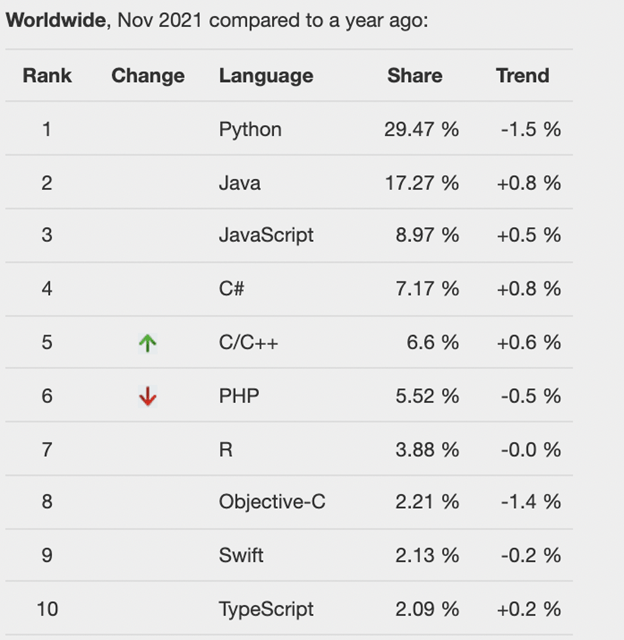
Screenshot from PYPL
MagicBell’s Top 10 Programming Languages
We reviewed the data from the lists above to arrive at the most popular languages; the more mentions a programming language has in the 5 rankings, the higher its overall rank. (C and C++ are considered together.) Accordingly, our rankings for the most popular programming languages are listed below, along with the number of mentions they each have.
(It should be noted that some languages have the same number of mentions and are considered to have the same ranking. Hence, there are a total of 11 languages on the list as several languages have two mentions.)
- JavaScript: 5
- Python: 5
- Java: 5
- C++/C: 5
- C#: 4
- Typescript: 4
- PHP: 3
- SQL: 2
- Bash / Shell / Powershell: 2
- Ruby: 2
- HTML/CSS: 2
We will look at each of the top 11 languages in the following sections.
JavaScript
JavaScript was developed in 1995 by a programmer for Netscape, Brandan Eich. This popular programming language was developed in just 10 days and, thanks to its wide range of applications and flexibility, has since become the default client-side programming language of the internet. Today, it can be used for full stack development thanks to the launch of Node.js, a backend runtime, which made it possible to use JavaScript for server side scripting as well. This is a big perk for front end developers, as it allows them to handle backend development tasks without learning a new language. According to W3Techs, JavaScript is the #1 client-side programming language and is used in 97.7% of all websites worldwide.
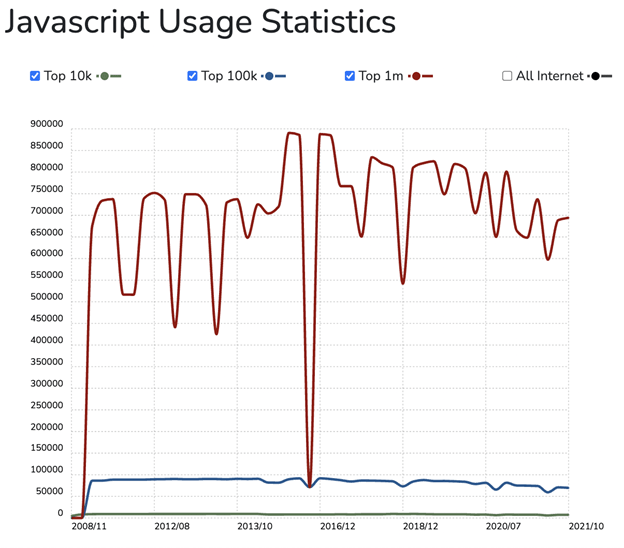
Screenshot from BuiltWith
In the image above, which utilizes 13 years’ worth of data from November 2008 to October 2021, we can see that JavaScript has been consistently used in the top websites of the world. However, the Google Trends information paints a different picture, with the query volume for the keyword ‘JavaScript’ peaking in 2004 and steadily declining since then.
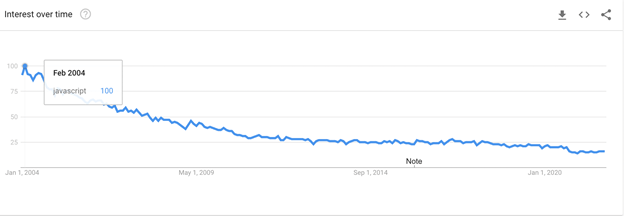
Source: Google Trends
Python
Python was developed in 1991 by Guido van Rossum as an object-oriented programming language and, based on the number of users, is the fastest growing programming language in the world. One big advantage of Python is its versatility, which allows it to be used for a variety of applications. For example, not only can it be used to build websites, but it can also be used in advanced machine learning applications.
As noted earlier, the PYPL popularity index tracks the search results for language tutorials, and as of November 2021, Python accounts for 29.47% of all searches in this area. Python is clearly on an uptrend that isn’t going to diminish any time soon. Google Trends data paints a similar picture, as the search volume for the Python programming language has seen some impressive growth for more than a decade and a half.
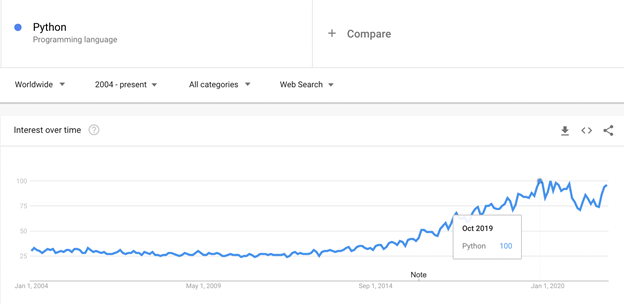
Source: Google Trends
Java
Java is a high-level language developed by James Gosling in 1995 and is currently owned and maintained by the Oracle Corporation. The advantage of Java is that the same code can be run on any machine, regardless of hardware, as long as the machine has the Java Runtime Environment installed. This makes programmers’ lives much easier, as they only need to write code once and that same code can then be run on a wide range of machines.
Java is ranked among the top programming languages in all of the five publications used for this article. This shows the strength of both the language and its developer base, as its “code once, run anywhere” model makes it a darling among developers. That said, as with JavaScript, Google Trends paints a different picture, with the search volume for Java peaking in 2004 and on a steady decline ever since. New developer interest in Java is therefore less than the languages on the upswing, such as Python.
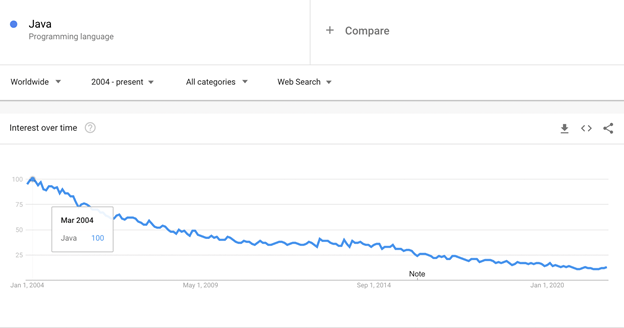
Source: Google Trends
C++/C
The C programming language is nearly half a century old. Developed in 1972 by Dennis Ritchie for Bell Laboratories, the language gained popularity over the decades in a wide range of applications, such as industrial automation software. C++ was introduced in 1985 as an extension of the original C language and became a popular choice for teaching programming skills to students in schools and colleges. Like its predecessor, C++ also has a wide range of applications.
In the rankings selected for this article, we can see that although C and C++ remain popular, their popularity is waning. Google Trends also paints a similar picture, with the term C++ peaking in search queries in 2004 and then steadily declining.
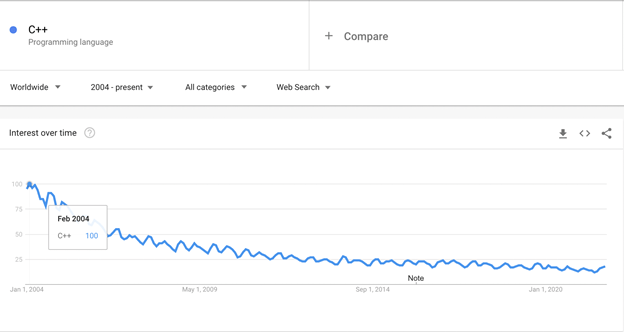
Source: Google Trends
C#
C# was developed by Microsoft as an alternative to Java for Windows-based computers. Released with .NET in 2002, it is primarily used today for developing mobile applications and games, with many developers choosing to learn and build applications with C# due to its open-source nature.
According to the PYPL index, there is a high demand from new developers to learn C#, and it has the fourth-highest number of search queries for tutorials. Again, as with other languages, the data from Google Trends shows a different picture, with the search volume on a downtrend since peaking in 2005.
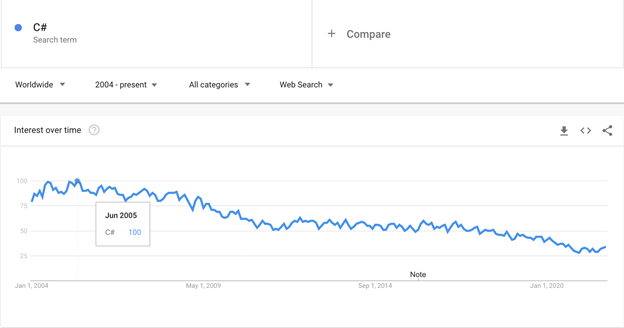
Source: Google Trends
Typescript
Typescript is the latest language featured in this list of most popular programming languages. Released in 2012, it was designed with the objective of writing clean JavaScript code by making use of the libraries and APIs designed for that language. As such, TypeScript can be considered a superset of JavaScript.
Being the most recent language featured, TypeScript is gaining popularity fast and is featured in three of the five rankings chosen for this article. Google Trends tells a similar story, with a steady increase in search queries since 2014.
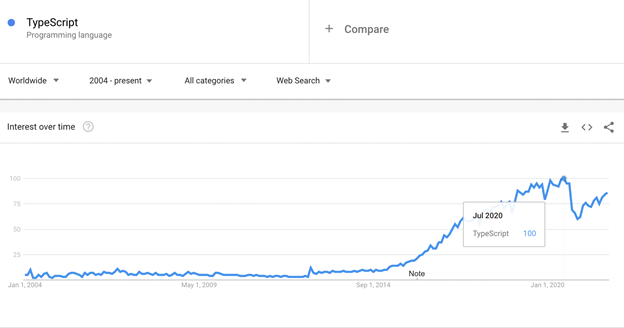
Source: Google Trends
PHP
PHP is a server-side scripting language that was created by Rasmus Lerdorf in 1994. PHP used to be one of the most popular programming languages in the world, but its popularity has been decreasing in recent years. One of the factors that contributed to the popularity of PHP is WordPress, with the open-source content management system using PHP as its primary programming language.
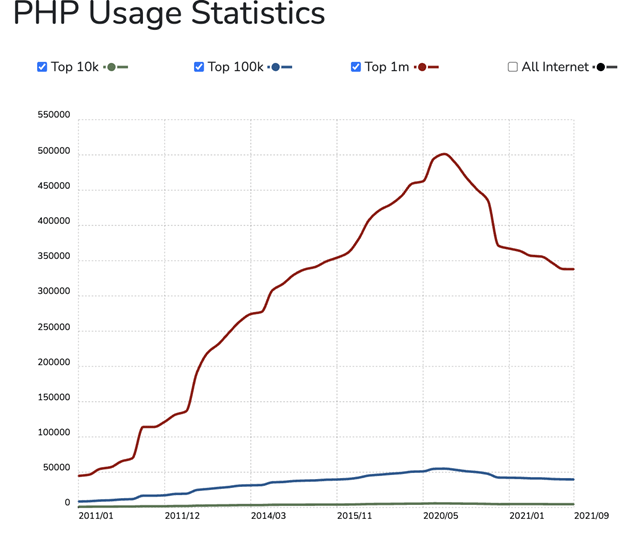
Source: BuiltWith
According to data from BuiltWith, almost a third of the top million websites use PHP. Despite this, the programming language has been declining in popularity in recent years, with search queries on a decline since 2004.

Source: Google Trends
SQL
SQL (Structured Query Language) is used to interact with relational databases. This is a domain-specific language that finds a place among the most popular programming languages due to its common usage with databases. Most RDBMS use SQL for CRUD (Create, Read, Update, Delete) operations, and SQL can be integrated well with other programming languages for database-related tasks.
With the rise of unstructured data and different languages used for unstructured databases, SQL has been decreasing in popularity over recent years. Google Trends confirms this, with the search volume for SQL on a decline since its peak in 2004.
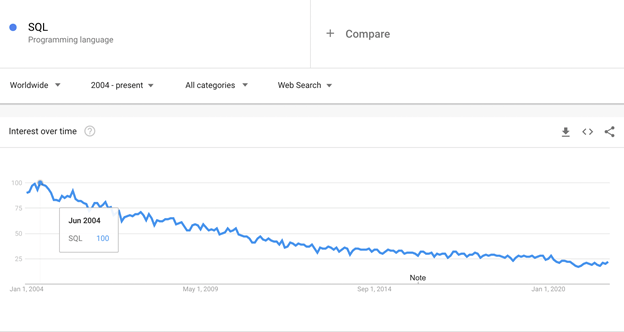
Source: Google Trends
Bash / Shell / Powershell
Languages used to run on the shell of UNIX-style operating systems are called shell scripts and are referred to as Bash, Shell, or Powershell languages according to the operating system. Shell scripts have been gaining in popularity in recent years due to the rise of cloud computing. With cloud computing, developers access the command line of the cloud systems that are used to deploy the applications. This necessitates the use of shell scripting languages.
Google Trends data shows that the search volume for the term Powershell exploded in the last decade, and this increase is a long-term indicator of Shell/Bash/Powershell potentially gaining in popularity over the next few years.
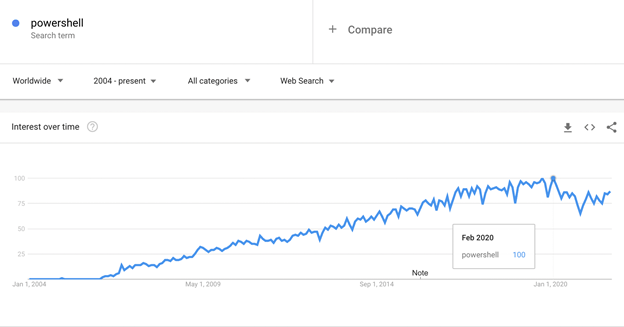
Source: Google Trends
Ruby
Ruby is an open-source programming language with an elegant syntax focused on making coding simple and easy. The language was developed by Yukihiro “Matz” Matsumoto in Japan. Today most programming languages are also making coding simpler and, as a result, Ruby has been losing ground in recent years.
According to the PYPL Index, the market share for Ruby tutorials is a paltry 1.05%, indicating that the interest of new developers in Ruby is waning. Google Trends data paints a similar picture with search volume consistently declining since it peaked in 2007.
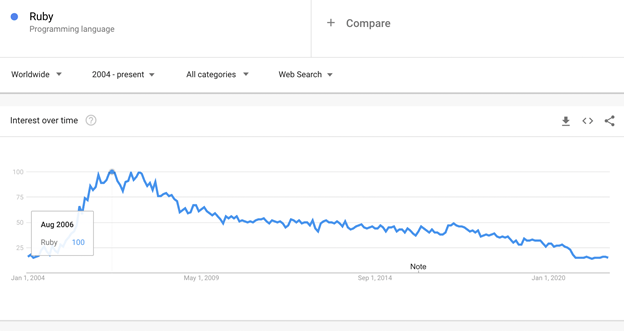
Source: Google Trends
HTML/CSS
HTML and CSS form one of the most basic building blocks of the internet, with HTML being used to display information on websites and CSS helping to style it. All websites need HTML and CSS to function, and both HTML and CSS are simple and easy to learn. As a result, there aren’t too many search queries for tutorials or for HTML and CSS as a whole. This is the reason why they score less in popular programming languages even though their use is ubiquitous over the internet.
There are also automated solutions that generate HTML and CSS code, requiring fewer developers to know the languages. This is another factor in their decreasing popularity, with the search volume for HTML consistently declining since Google first started to track its search data.
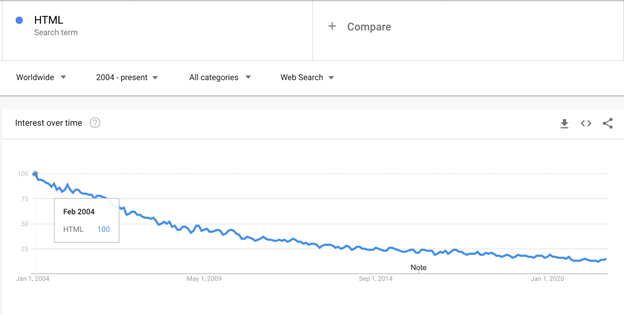
Source: Google Trends
Conclusion
Over the years many languages have gained popularity while many others have seen their popularity decline. One consideration when it comes to Google Trends data is that while search trends are on the decline for some of the most popular programming languages, the fact that those languages have been around for years means that there are many programmers who already know and use it, therefore there are fewer developers searching for it.
More technological advancements will demand simpler programming languages that are more developer-friendly, and this demand will be met by the creation of newer languages.
The list of the most popular programming languages has seen consistent change over the last few decades, and this change is expected to continue for the foreseeable decades to come.
Related articles:
